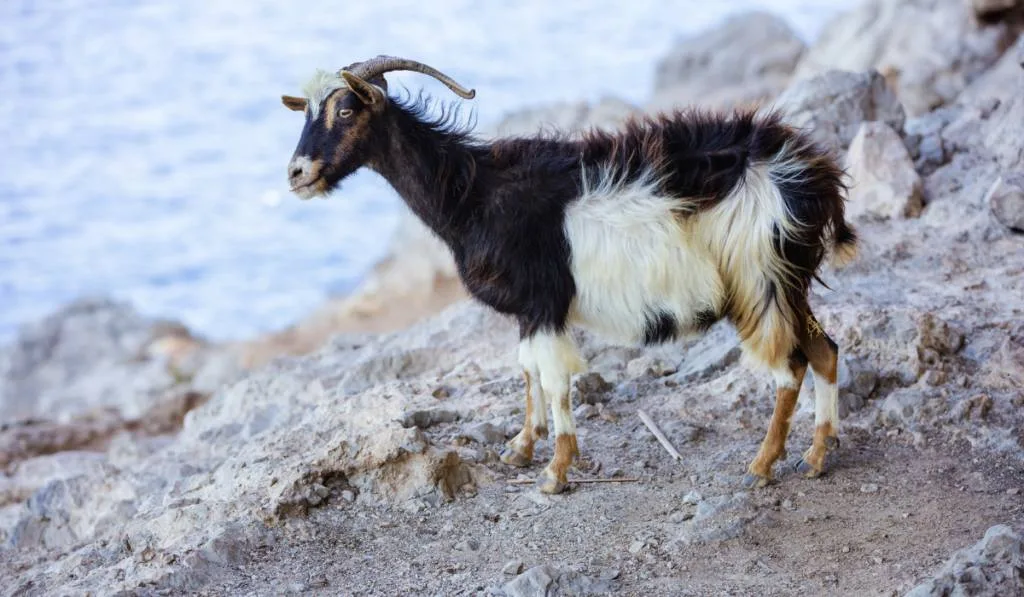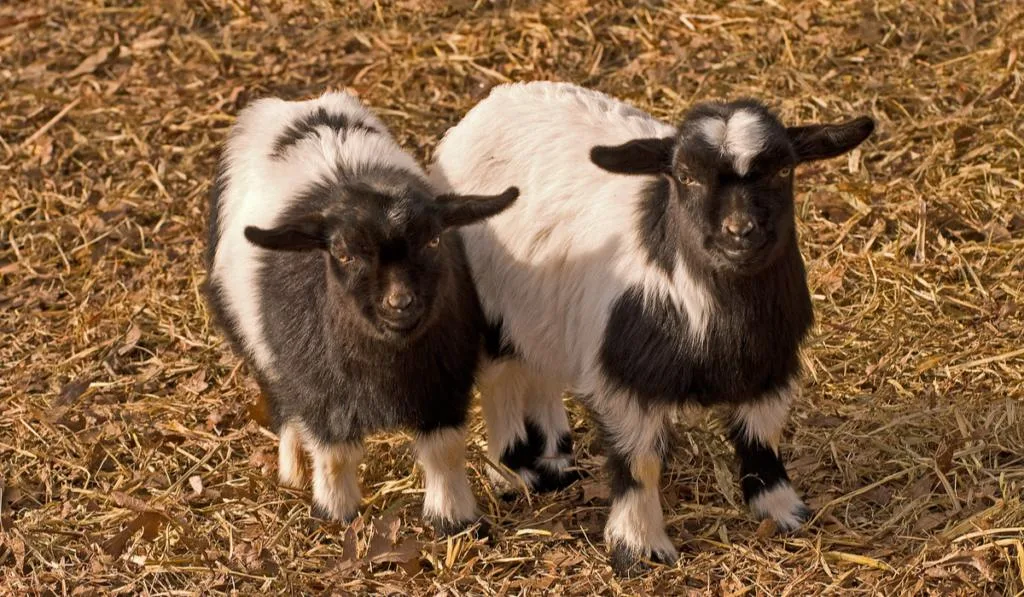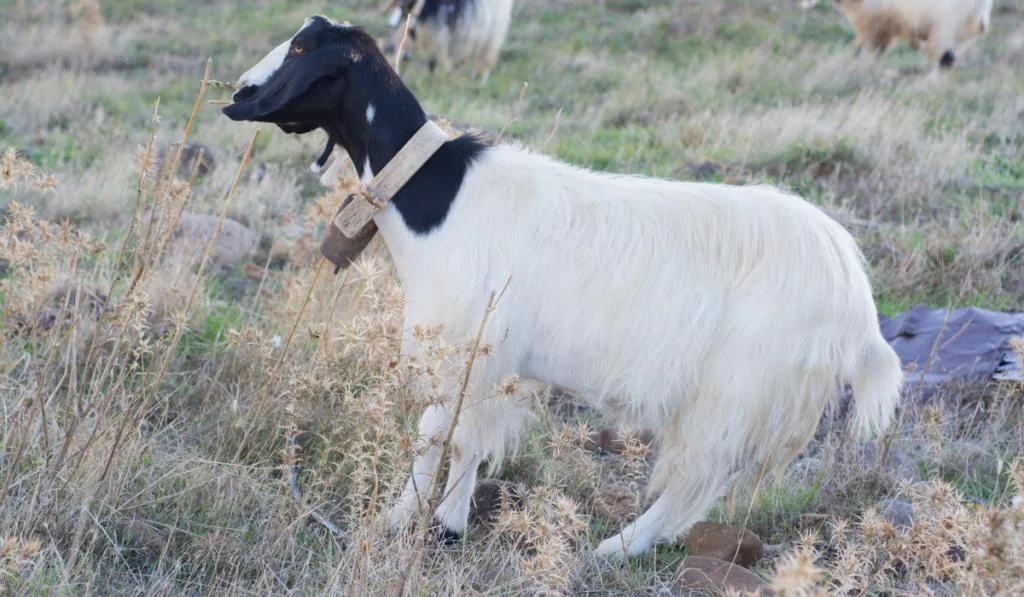Like dogs, birds, pigs, horses, and cattle, goats can also be pied. In animals, to be pied is to have a coat with a pattern of pigmented and unpigmented spots.
Depending on the breed, goat coats come in various solid colors. In some cases, they come with more than one color at once.
Of the many possible color combinations goat coats can have, the black and white combo fits the description of what it is to be pied.
If you want to know more about goat breeds with pied coats, we cover the details of nine black and white goat breeds in the rest of this article.

Table of Contents
French Alpine
The French Alpine is a goat breed indigenous to the French Alps. French Alpine goats are domestic dairy goats, and they are one of the most commonly kept breeds.
French Alpine females should weigh at least 135 pounds, reaching a height of 30 inches at the withers. Males should not weigh less than 170 pounds with a height of 30-40 inches at the withers.
French Alpine does are used primarily for milk production. Their milk is of high quality and is used in making cheese, soap, and butter.
The development of the French Alpine goat was more focused on production and size rather than color patterns.
However, the coats come in various colors, including Cou Blanc, Cou Clair, and Cou Noir. The Cou Noir variations have black necks, black front quarters, and white hindquarters.
Both male and female goats have short hair with the bucks having a roach of long hair along their spine. The beard of male French Alpine is also quite pronounced.

Bagot
Bagot goats have been living a semi-wild life at Blithfield Hall in Staffordshire, England. The Bagot has a documented ancestry and is said to be the oldest goat breed in Britain.
In the 1380s, the Bagot was introduced at Blithfield Hall. It seems they were brought to England by returning crusaders. Their ancestry can be traced to the goats of the Rhone valley.
Bagots are small to medium-sized goats. Their horns are large, curved, and sweep backward with some lateral twist.
The head and front quarters of the Bagot are predominantly black, while the hindquarters are white. Some Bagots have a white blaze on their faces and black patches on their hindquarters.
Bagot goats find applications in conservation browsing. They may also be reared for slaughter.

British Alpine
The British Alpine goat was developed in Great Britain by crossing Alpine goats imported from Switzerland with local goats in 1903.
In 1958, the first British Alpine goats arrived in Australia. They have since been enhanced using Toggenburg and Saanen does.
The average height is 37 inches for bucks, while for does, it is 32 inches at the withers. British Alpine goats are graceful, tall, and rangy. They are usually black with white markings, which tend to fade as they get older.
At birth, their tassels and horns may or may not be present. The ears of a British Alpine point forward and are erect. Their coats are shiny, short, and fluffy, although the bucks typically have longer hair.
British Alpine goats flourish in temperate climates but do not thrive in areas with high humidity.
British Alpine does are used for milk production, with the fat yield averaging four percent. They also have a prolonged lactation period – contributing to their excellent milk yield.
Frontalasca Goats
The Frontalasca goat is similar to the Swiss Grigionese Goat and is from Frontale in Val Rezzalo, Italy. Frontalasca goats are reared in the valleys of Valchiavenna, Val Masino, Valtellina, and Val Malenco.
Female Frontalasca can reach heights of 31-32 inches at the withers and weigh 143-154 pounds. Frontalasca goats have black coats with white streaks on the sides of their sub-caudal area, bosom, and heads.
Frontalascas have long, saber-shaped horns and shiny, thick hair. Although Frontalascas are dairy goats, they may also be bred for meat production.
Jining Grey
The Jining Grey is indigenous to the Shandong Province of China.
Well-raised Jining Grey goats typically reach maturity within 3-4 months and may birth two kids in a year or three in two years. Their rate of reproduction is high, with an average birth rate of 294 percent.
Both male and female Jining Grey carry a forelock and have horns.
Jining Grey color patterns vary between white, black, or white and black. They are small-sized goats with females weighing 55 lbs., while males weigh 75 lbs.
Jining Greys are used for cashmere fiber and kid pelt production because of the attractive wavy patterns.
Coats from males yield 18-30 percent cashmere fiber while those from females are lower, containing 16-20 percent cashmere fiber.

Peacock Goats
The Peacock goat is indigenous to the Upper Tessin and the cantons of Graubünden in Switzerland. The Peacock goat was discovered in 1887, although little is known about its origin.
The first name it was given after its discovery was the Striped goat.
It was later changed to the Peacock goat after a reporter’s spelling error. The Peacock goat is also called Razza Naz, Gray-Black Goat, and the Gray-Black-White Mountain Goat.
Most of the body of a Peacock goat is white. However, its boots and rear body are black in most places. It has a thick, medium-length coat.
Peacock goats have large horns with dark stripes or spots from the base of the horns, over the eyes, and nose. They are bred mainly for milk production.
Vallesana
Vallesana goats are Italian goat breeds also known as Walliser Schwarzhals, Valais Blackthroat, and Col Noir de Valais. They are indigenous to the border between the Swiss canton of Valais and South Novarese in Italy.
Male Vallesana goats weigh 165 lbs. with a height of 29-33 inches at the withers. Females weigh 121 lbs. with a height of 27-31 inches at the withers.
The hindquarters of the Vallesana are white. However, the shoulders, the neck, the head, and the front legs are black.
The line between both colors is impressive and well defined. Although the Vallesana produces milk, they are reared primarily for their meat.
Vallesana Goats have wavy, long hair and medium-length horns.

Tennessee Fainting Goat
The Tennessee Fainting goat goes by several names, including Texas Wooden Leg, Tennessee Meat, and Tennessee Fainting goats.
Their name comes from a condition known as myotonia congenita – a condition in which muscles contract for a prolonged period when the goat is frightened.
Tennessee Fainting goats are a bit small-sized. They usually reach heights of 17-25 inches and weigh between 60 and 174 lbs. Male goats or bucks can weigh as much as 200 lbs.
Although Tennessee Fainting goats have short hair, it is not unusual to see these goats with long hair. In fact, some are used for cashmere production. Most Tennessee Fainting goats are black and white, but other colors also exist.
The facial profile of the Tennessee Fainting goat is usually concave. Their ears are held more horizontally and are larger than the Swiss breeds. However, they are smaller than those of the Spanish or Nubian goat breeds.
Tennessee Fainting goats are heavy-rumped and deep-chested animals used primarily for meat production. They are also good mothers and excellent for milk production.

Maltese Goat
The Maltese goat is a breed from the central and eastern Mediterranean area. Maltese goats originate in Asia Minor and get their name from the island of Malta. They are raised on the islands of Sardinia and Sicily in southern Italy.
The average height of Maltese bucks is about 34 inches, and they weigh 154 lbs. on average. While does are about 27 inches tall and weigh about 101 lbs.
Maltese goats are beautiful medium-sized goats with long hair. They also have long ears and a raven-black area at the top and sides of their head.
They have a white face with black ears, a black crown, and black sides. Maltese goats have pinkish-white skins, but where the coat is black, their skin color is dark.
Maltese goats are bred for their milk. They produce an average of 1102-1322 pounds of milk per lactation. Their milk tastes pleasant and does not have an excessive goaty flavor.
Maltese Goats do not usually have horns, but bucks are bearded.
Resources
- https://goats.extension.org/goat-breeds-alpine/
- http://www.livestockoftheworld.com/Goats/?ScreenWidth=1366
- https://bagotgoats.co.uk/about-bagot-goats/
- https://salecreek.vet/breeds-of-goats/
- https://livestockconservancy.org/index.php/heritage/internal/tennfaint
- https://www.dpi.nsw.gov.au/animals-and-livestock/goats/breeds/british-alpine
- https://www.roysfarm.com/maltese-goat/
- http://eng.agraria.org/goat/frontalasca.htm
